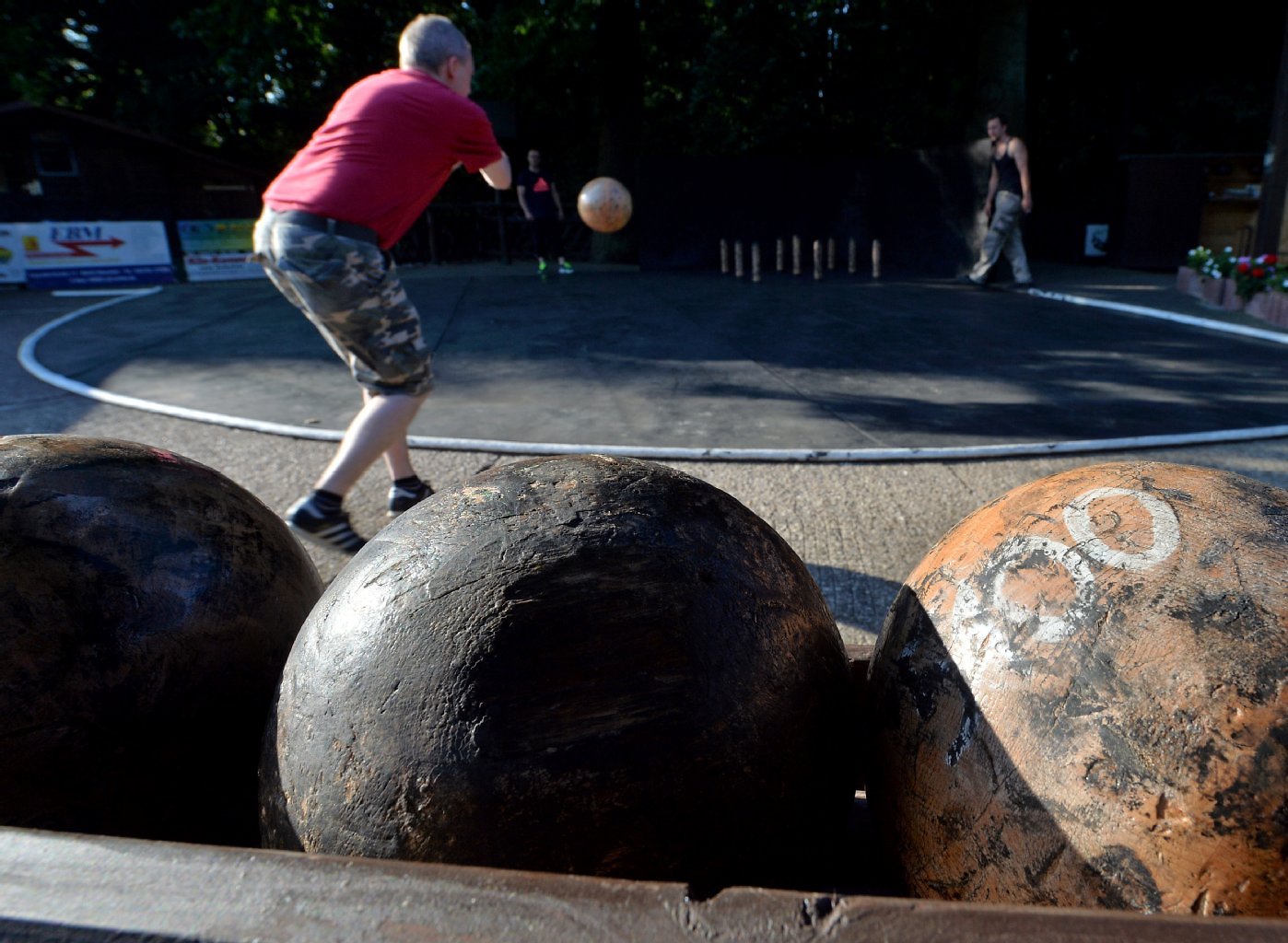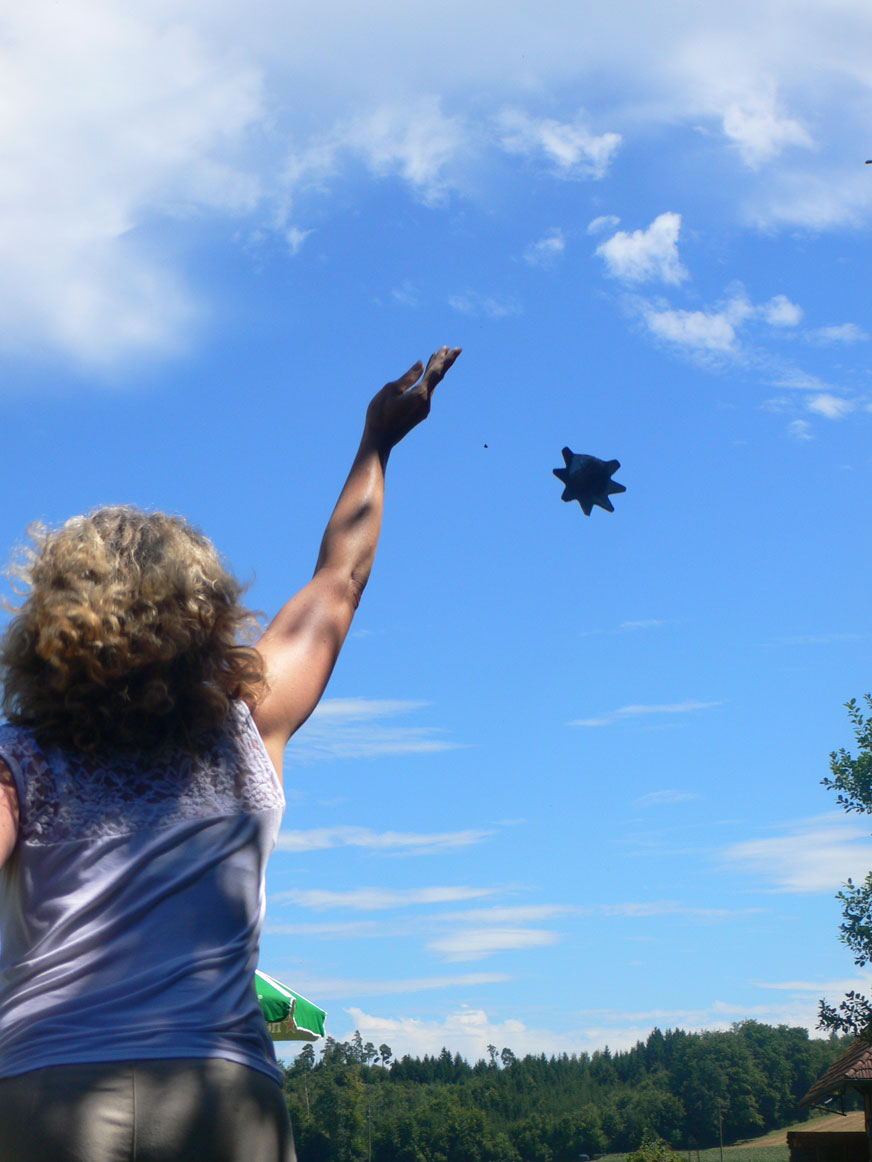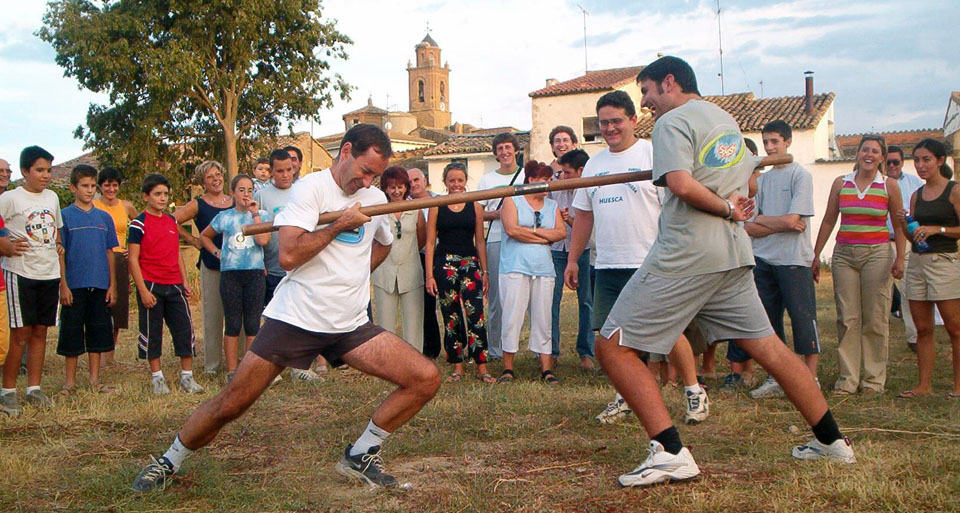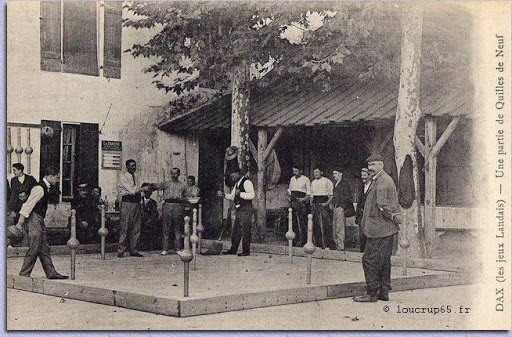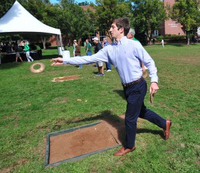- Name of sport (game): Pesäpallo
- Name in native language: Pesäpallo
- Place of practice (continent, state, nation):
Finland
- Sources of information :
- Name of sport (game): Picken
- Name in native language: Picken
- Place of practice (continent, state, nation):
Germany
- Description:
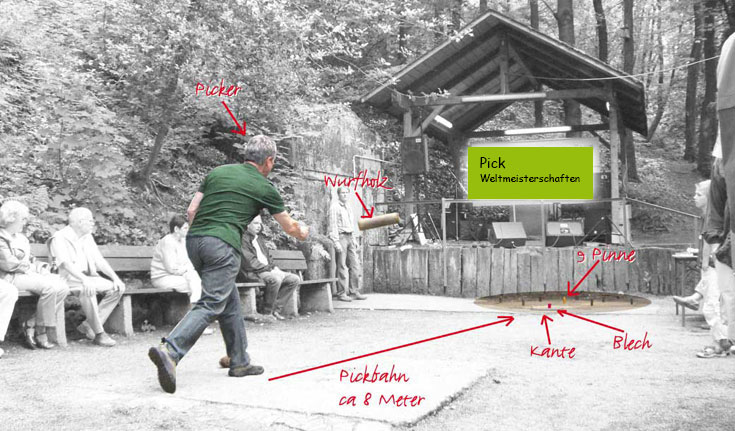
- Contacts:
Pickverein Grüne Eiche e.V.
Vonkeln 80 in 42349 Wuppertal
Vorsitzender:
Friedrich Wilhelm Ackermann
Hensges Neuhaus 1 in 42349 Wuppertal
Telefon: 0202 47 38 98
http://www.pickverein.de/
e-mail:This email address is being protected from spambots. You need JavaScript enabled to view it.
Fb: https://www.facebook.com/Pickverein-Gr%C3%BCne-Eiche-430291700355969/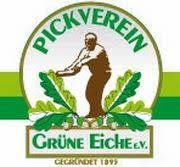
- Sources of information :
- Name of sport (game): Ringnetball or Ringball/The net ring ball
- Name in native language: Pierścieniówka
- Place of practice (continent, state, nation):
Poland (occasionally in Spain, South Korea, Canada and others)
- History:
Origins
Pierścieniówka was invented by Włodzimierz Robakowski, Polish PE teacher, in the 1930s.
Robakowski was watching the fishermen, playing on the Mazurian Lakes (the biggest complex of lakes in Poland). They were throwing buoys through broken, leaking nets, which were no longer used for fishing. Inspired by this, he decided to check how to throw the ball through a similar net.
This Polish teacher already knew volleyball, which was founded in the late nineteenth century in the United States by another teacher – William Henry Morgan – as a part of physical education in local schools.
Robakowski used a net in which he cut out three holes resembling those ones from the fishing nets.
The experiment with throwing a ball through them was successful and he decided to create a sport that he called "ringnetball". The first part of this name comes from the holes in the net which resembles rings.
Robakowski even wrote and published a book about it, entitled "Pierścieniówka – gra sportowa dla młodzieży” (1936) – Eng. Ringnetball – a sports game for youngsters. This sport had a good chance of further development.Ringnetball and basketball
The genesis of the Ringnetball is a bit similar to the beginnings of one of the most popular sports in the world – basketball. The latter was invented by James Naismith, who was watching American farmers throwing melons into the wicker baskets. Naismith hung such baskets (still with the bottom) to the balconies in the gym, gathered a group of students and played a test match (initially 9 players each side). The bottoms of the baskets were not practical, as it was difficult to get the ball from them after a successful throw so they were quickly cut out.
Over time, further modifications were made and this sport was popularized simultaneously in the US and in other countries (by, among others, American soldiers in Europe).
One may ask – why basketball has become so popular and Ringnetball not (or not yet)?
The reason was the outbreak of the World War II. Poland found itself in the middle of one of the biggest conflicts in the human history. This ruined plans to develop and popularize many forms of Polish, cultural heritage, including Ringnetball. This sport was forgotten.Reviving of Ringnetball
At the beginning of the 21st century, thanks to Professor Wojciech Lipoński and Professors Małgorzata and Michał Bronikowski from the University School of Physical Education in Poznań, this sport was brought back to life. In 2003, first, "experimental" Ringnetball game was played. Its rules have been changed a bit to make this game more dynamic.
Ringnetball passed this test successfully and began to be promoted by its creators at the University and during conferences, presentations, practical classes and activities, festivals and many other events in Poland and abroad, among others at such large and important sporting events as the World and European Games of Traditional Sports (2008, 2012, 2016, 2018) or during the first European Week of Sport in Brussels (2015). - Description:
This sport consists of throwing the ball with two hands through three holes (rings) in the net. The middle one is the largest (diameter 70cm) and two side ones 50 cm each. There are usually
4 players on each side of the court. Three players are in the back (behind a line 1.5 meters from the net). Their task is to catch the ball and pass it to the other players of their team or throw through the holes in the net.
The game begins with a serve from the end line of the court. The server hits the ball above the net, like in volleyball. Then, however, the opposing team has to catch it and either pass or throw the ball through one of the holes.
The fourth player is the playmaker. He or she stands in the 1.5-meter zone closest to the net. His or her task is only to pass the ball to other players of his/her team. He/she cannot throw it through the holes or block them with his/her own body. After each action, there is a rotation of players – they change their positions so as everybody could serve, be a playmaker and throw the ball through all the holes.
You usually play best of 3 or best of 5 sets up to 15, 21 or 25 points each (except for tie-breaks up to 15 points). Of course, it can be easily changed depending on the needs.
Pierścieniówka is a dynamic game that works well for children and adolescents, as well as adults and the elderly.
People with disabilities can also play it, what was proven by the Sports and Rehabilitation Association START from Poznań thanks to the implementation of the EU Erasmus + Sport project entitled: “Activation and integration of people with disabilities through adapted traditional games”.
The author of this text took part in this project as an expert in traditional sports.
People with disabilities (including those in wheelchairs) played Ringnetball and other traditional games together with the able-bodied thanks to the adaptations of these sports to their needs. It was a successful initiative, implemented not only in Poland, but also in the project's partner countries (Turkey, Bulgaria and Macedonia).
The elderly can also play this sport which the author proven by running the successful, practical activities for the students of the University of the Third Age at the Vistula University in Warsaw. - Current status:
Since its revival, Ringnetball has been increasingly presented at important sporting events around the world, including as important as the already mentioned World Games of Traditional Sports. Children and adults from around the world had the opportunity to play many traditional sports and games, including ringnetball, there.
This Polish sport was also shown during the first edition of the European Games of Traditional Sports in Friesland (the Netherlands) in 2018.
You can also play this sport during various events in Poland. Ringnetball is presented and offered by our teams as an attractive, dynamic game at integration events and festivals such as Majówka (Mayday), Children's Day, St. John's Fair, Integration Festival in Poznan and many others. Sometimes you can also play this sport in other Polish cities.
Anyone interested is welcome and can play Ringnetball in these places.
Ringnetball is also slowly entering schools. For instance, at the Primary School in Czempiń
(a small town in Western Poland), this sport was introduced to physical education classes by Jan Prabucki – an experienced physical education teacher, a successful football coach on a national scale, the founder of the students sport club "AS" and a distinguished educator of many generations of young sportsmen. Ringnetball enjoyed considerable popularity among the female pupils of this school.
You can also play Pierścieniówka during practical activities and classes for children.
It is even possible to play 1 on 1. However, it is more attractive as a team sport. It is best to play 4 players a side but Ringnetball, as many other traditional sports, is very flexible. You can change the number of players, adjust the height of the net and dimensions of the pitch to adapt it to the needs of the given participants. - Importance (for practitioners, communities etc.):
Pierścieniówka is coming back and it is worth it!
Pierścieniówka (Ringnetball) is a traditional Polish team sport, invented in similar circumstances as basketball and volleyball. Due to the Second World War and its effects, it has never had the chance to be developed like the latter disciplines popular today around the world. Reconstructed in the 21st century, however, it is returning step by step.
When appropriately adapted to the players' needs, it is an attractive, dynamic team sport, available to all interested people and bringing them the joy of a common, integrative participation in an old/ new form of physical activity.
It teaches coordination and balance and other physical skills. It is also good for shaping social skills – cooperation, decision-making process but also good competition. It also increases cognitive competence, such as strategic thinking.
Moreover, it is an element of cultural heritage of Poland. Derived from the simple play of fishermen, it developed to the form of a regular, team sport, having a potential of being a national game of Poland. - Contacts:
Bartosz Prabucki, PhD, expert in traditional sports, Institute for the Development of Sport and Education (IRSiE),
https://inspirowanysportem.pl/en/ringnetball-polish-traditional-sport/ - Sources of information :
https://inspirowanysportem.pl/en/ringnetball-polish-traditional-sport/
- Gallery:
- Name of sport (game): Platzbahnkegeln
- Name in native language: Platzbahnkegeln
- Place of practice (continent, state, nation):
Saxony-Anhalt, Germany
- History:
Bowling was the popular sport in the Mansfelder Land and is said to have been introduced here with the upswing of mining by Austrian and Upper Bavarian miners who looked for a change after work and knew the game from Italy. There the cones were set up in the middle of a circle about ten meters in diameter and an attempt was made from the edge to "clear the space" by throwing a ball. Championships have been held there since 1964.
- Description:
The square bowling is a regional special form of bowling in which the ball is thrown in the traditional way instead of being rolled. It usually takes place outdoors and is a competitive sport only in the Mansfelder Land and southern Saxony-Anhalt.
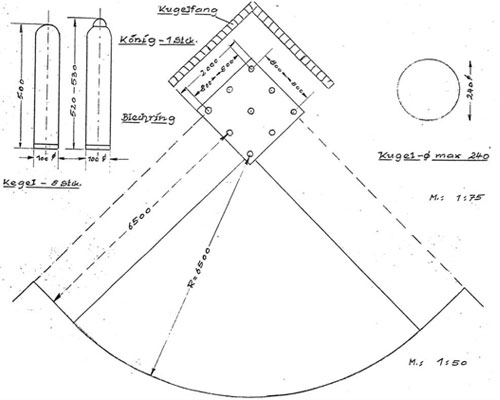
For the square bowling in the Mansfelder Land, the square was reduced to a quarter circle and the cones were set up at a distance of 6.5 meters from a marked stand area and 80 centimeters below one another. The approximately five kilogram wooden ball is up to 24 centimeters in diameter, a cone 10 centimeters. This is made of hardwood (usually hornbeam) and is 60 centimeters high (the king 3 centimeters higher). The standing surface of the cones is fixed and provided with a rubber mat. Around 80 centimeters behind the cones, a trap wall will be built to protect the spectators and the material. The standing area for the players is usually laid out with plaster and provided with a drop edge. - Current status:
Practiced
- Contacts:
Verband der Platzbahnkegler Sachsen - Anhalt e.V.
This email address is being protected from spambots. You need JavaScript enabled to view it.
www.platzbahnkegeln.de
- Sources of information :
Video:
www.youtube.com/watch?v=FgTaHJ4vutE&t=130s
https://www.youtube.com/watch?v=_gp9yZOpbjI
https://www.youtube.com/watch?v=hggG2N20d18
https://www.youtube.com/watch?app=desktop&v=dm5QgljyZFk - Gallery:
- Name of sport (game): Platzgen
- Name in native language: Platzgen
- Place of practice (continent, state, nation):
Switzerland
- History:
Platzgen is a Swiss sport that has its origins in the Middle Ages and is mainly played in the canton of Bern.
- Description:
The aim of the game is to place a specially made metal disc ("Platzge") with a maximum diameter of 18 cm and a weight of 1-3 kg over a distance of 17 m (men) or 11.5 m (women) into a circular clay target "Ries".
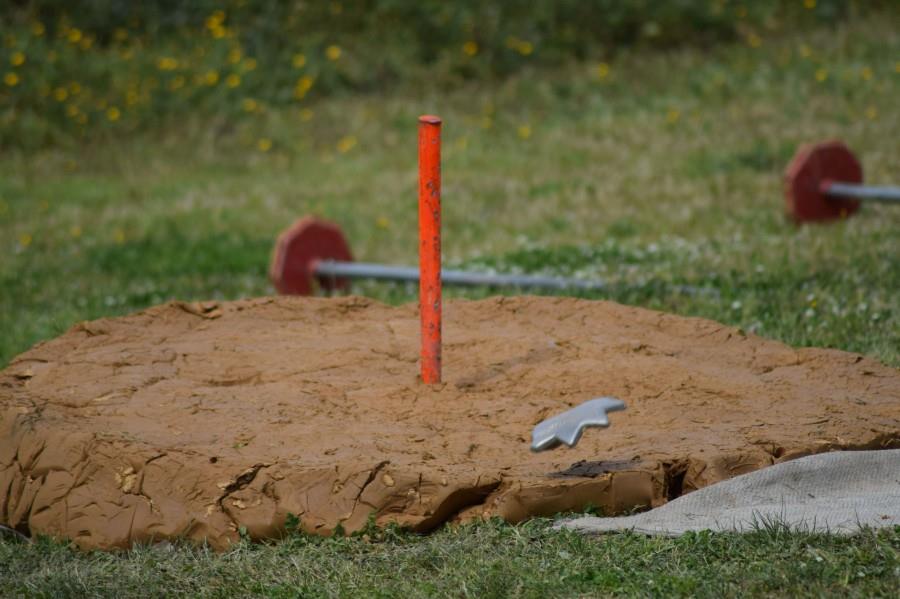
Ries has a diameter of 1.4 m and is increased by 25 cm at the back. In the middle of the Ries there is a 35 to 40 cm high iron stick ("Schwirren"), which is perpendicular to the target surface.
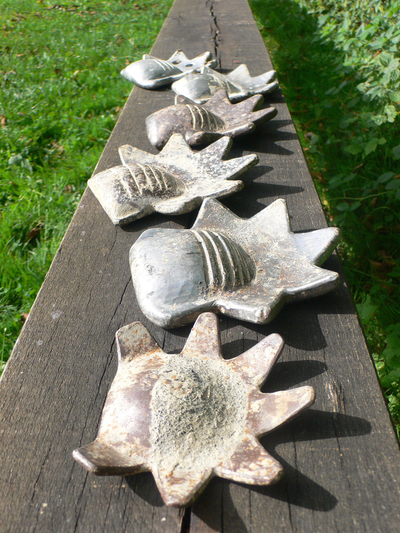
The maximum number of points of 100 is reached when the Platzge touches the Schwirren. One point is deducted for every centimeter from the Schwirren.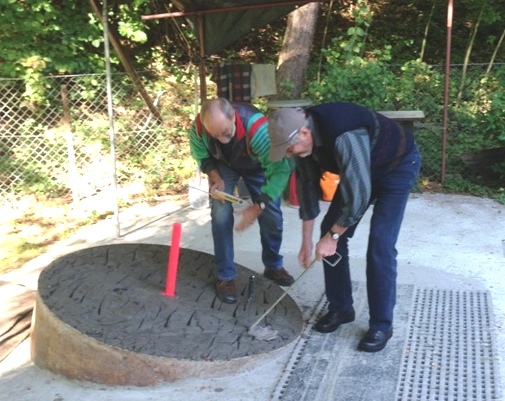
- Current status:
Practiced
- Contacts:

Web: www.platzgen.ch
- Sources of information :
Video:
www.youtube.com/watch?v=PUDEM3K9LNI
www.youtube.com/watch?v=srhbDBKBsVw
www.youtube.com/watch?v=JN1-C0gHS6E - Gallery:
- Documents:
- Name of sport (game): Pljočke
- Name in native language: Pljočke
- Place of practice (continent, state, nation):
Croatia
- History:
Pljočkanje is one of the oldest known traditional sports, of which there are archaeological artifacts dating back more than 5,000 years. In the Republic of Croatia it is played along the Mediterranean belt, and we are in possession of several stone "pljočka" found in archaeological sites dating back to the early Middle Age.
- Description:
Pljočkanje is a precision throwing sport that requires skill, technique and strategy. It is played between two opposing teams. It is played with a set of "pljočke" in a rectangular field-a playing field is bounded by a rope. Players try to win the greatest number of points expected to win.

Each team wins one point for each pljočka closer to the bulin than the opposing team's closest; points are counted after all pljočka have been played.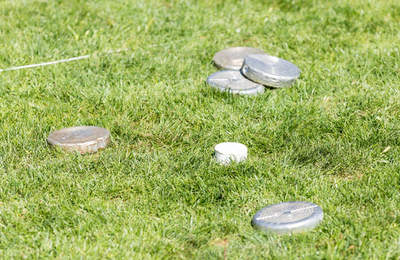
The game begins by drawing two teams, and the one that wins has the right to choose the side, the color of the pljočke to be used and to throw the bulín into the playing area and start the game by throwing the first pljočka. After throwing the bulín and the first pljočka, the opposing team must play their pljočka, one or more, until they have placed a pljočka closer to bulin than the opposing team's pljočka is. Once done, the other team will try to change the situation by gaining a point for themselves, and so on until all pljočka have been thrown.
When one team has no more pljočka to play with, the opposing team can play and try to score or win more points by placing their own pljočka closer to the bulin or by pushing the opposing pljočka in the way.
When all the pljočka of both teams have been played, i.e., the toss round has been completed, one of the teams will receive as many points as the number of pljočka closest to the bulin. The reference will be the pljočka closest to the opposing team's bulín.
Once the round is over and the points scored are determined, the second round begins on the other side of the playing field (opposite the first). The team that scored points in the previous round has the right to throw the bulin and the first pljočka.
The game ends when one of the team first wins the total number of points stipulated in the current rules. All necessary rounds must be played. The game is played until 13 points are won.
The terms "pljočka" and "bulin" refer to the names of props for the game.
- Current status:
The game has been maintained to this day, and a significant revitalization was initiated in the early 1990s. The Istrian Association of the Pljočka was appointed by the Ministry of Culture of the Republic of Croatia as a cultural heritage holder in 2016, and in addition to the National Register of Intangible Cultural Heritage, the "pljočkanje" has been included in the UNESCO Good Practice Register as part of the World Cultural Heritage in 2022.
- Contacts:
Istarski Pljočkarski Savez
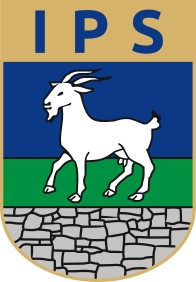
IPS is a non-governmental organisation founded in 2011 with the aim of revitalising, preserving and promoting 'pljočkanje'. By decision of the Ministry of Culture and Media of the Republic of Croatia, it was appointed as a cultural heritage holder in accordance with the UNESCO Convention on the Safeguarding of the Intangible Cultural Heritage. The IPS is very actively involved in education, documentation and research activities on traditional games and sports. President: Armando Fabijančić
Web: www.ips-pljockanje.hr
Fb: https://www.facebook.com/pljockarilanterna
Twiter: https://twitter.com/pljockar
E-mail:This email address is being protected from spambots. You need JavaScript enabled to view it. ;This email address is being protected from spambots. You need JavaScript enabled to view it. ;This email address is being protected from spambots. You need JavaScript enabled to view it. - Sources of information :
Video:
https://www.youtube.com/watch?v=XnSDq-wXyhw
https://www.youtube.com/watch?v=JdqoAhEmHp4Source of photos used in this article and gallery: Milivoj Pacenti, Kazimierz Waluch
- Gallery:
- Name of sport (game): Pontoniersport
- Place of practice (continent, state, nation):
Switzerland
- Description:
It's a competition for racing with transfer boats (Weidlingen) in an obstacle course.
The pontoon sport is a traditional water sport in Switzerland. He is supported by the Eidg. Departement für Verteidigung, Bevölkerungsschutz und Sport (VBS). This sport mainly involves rowing and spiking on rivers and lakes with transfer boats and weidlings. In addition to strength, this sport also requires extensive knowledge of the element of water. In contrast to driving on the water, not only short times are expected of the competitors in pontooning, but also - as training for bridge building - enormous precision when driving.
The term comes from the pontoons, those hollow ship bodies used to build mostly makeshift bridges. There is a connection between the pontooning driving clubs (also pontooning sports clubs) and the pontooning in the military sector. - Contacts:
Schweizerischer Pontonier-Sportverband

- Sources of information :
Video:
www.youtube.com/watch?v=YLC4Um3ZVr8
https://www.youtube.com/watch?v=_gicZ09APgA - Gallery:
- Place of practice (continent, state, nation):
Slovenia, Danmark
- History:
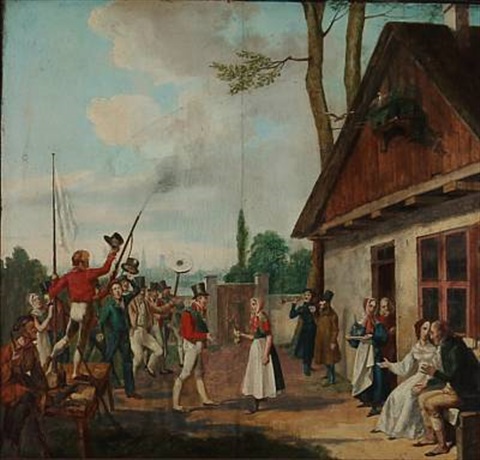 Christian (Claus C.) Tilly (Danish, 1800–1879), Popinjay shooting on Amager Island, Denmark, 1836
Christian (Claus C.) Tilly (Danish, 1800–1879), Popinjay shooting on Amager Island, Denmark, 1836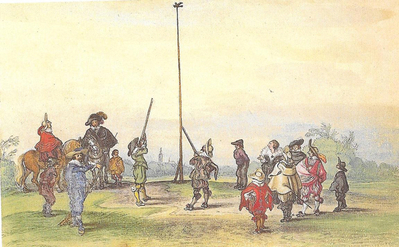
Popinjay shoot; Source Adriaen van de Venne’s Album, Martin Royalton-Kisch, British Museum, 1988
- Name of sport (game): Pulso de pica
- Name in native language: Pulso de pica
- Place of practice (continent, state, nation):
Aragon, Spain
- History:
It is the sport of Andalusian cattle herders, but it quickly caught on in Aragon and became popular throughout its territory.
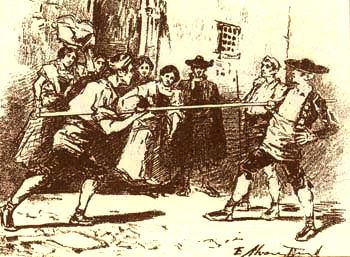 Source: https://misjuegostradicionales.wordpress.com/juegos-tradicionales-aragoneses/juego-de-la-pica/
Source: https://misjuegostradicionales.wordpress.com/juegos-tradicionales-aragoneses/juego-de-la-pica/ - Description:
Pulso de pica is a sport that requires strength and technique. The confrontation between two opponents is to push one of them out of the circle with the long stick they are both holding.
To compete, you need a stick (most often made of pine or beech wood), the length of which is 2-2.5 meters and a diameter of 4-5 centimeters. A circle with a diameter of about 4 meters should also be marked on the ground (the ground should be flat).
The players enter the circle and catch the stick (held by the judge) at both ends, facing each other. The grip is one hand, the stick is placed under the armpit, and the other hand is hidden behind you. The center of the stick must be in the center of the circle for both of them to have equal chances.
First, the judge commands "agarrar" (grab), then "tensar" (push). However, the competition only starts when the referee raises his hands (stopping the stick) and commands "tiro".
Various techniques are allowed, e.g. sitting down, moving around, but the stick should be grasped only on your side (you cannot cross the center with your hand).
Most often, the competition lasts up to three wins.
It should be remembered that the judge may give penalties for releasing the stick, touching the stick to the ground, detaching the stick from the body, etc. - Current status:
Practiced
- Sources of information :
Video:
https://www.youtube.com/watch?v=zPiR8n4vVmgSource of photos used in this article:
https://juegostradicionales.net/pulso-de-pica/
http://aragondeporteytradicion.blogspot.com/2019/09/pulso-de-pica.html
https://jugaje.com/es/culture2000/Aragon/Pulseo%20de%20Pica%20espagnol.htm
https://misjuegostradicionales.wordpress.com/juegos-tradicionales-aragoneses/juego-de-la-pica/
https://www.fanyanas.com/2011/08/el-tiro-de-barra-en-fananas-y.html - Gallery:
- Name of sport (game): Quilles de neuf
- Name in native language: Quilles de neuf
- Place of practice (continent, state, nation):
France
- Sources of information :
Articles:
http://sports.loucrup65.fr/quilles.htmSource of photos used in this article and gallery:
http://sports.loucrup65.fr/quilles.htm - Gallery:
- Name of sport (game): Quilles neuchâtelois, Neuchâtel skittles
- Name in native language: Quilles neuchâtelois
- Place of practice (continent, state, nation):
Switzerland (Neuchâtel)
- History:
The heyday of this convivial game was the late 19th and early 20th century; by the 1960s its popularity had waned considerably. Outdoor bowling alleys were set up next to métairies – country inns that were adjacent to dairy farms, and synonymous with the Neuchâtel Jura. Over time, these went to seed as open-air bowling fell out of favour. In contrast, indoor bowling alleys, many of which date back to the 1930s are still used and maintained by the four local skittles clubs.
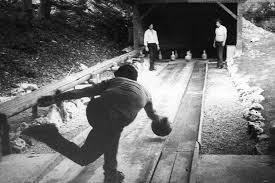
- Description:
Neuchâtel skittles, a forerunner of ten-pin bowling, is a game where players try to knock down nine bowling pins with a wooden ball. What makes the Neuchâtel version unique is that the bowling alley consists of two planks of wood that are joined together to form an upturned V-shape. A pinsetter ensures that the skittles are placed in their correct position. One point is given for each overturned skittle, however the throw does not count if the player fails to knock over the front skittle.
Players practice every week and compete against one another in various tournaments, such as the “Course Suisse”, the “Challenge de l’Impartial”, the “Championnat de l’Intercantonale”, and the very special “Challenge du 60e “, which is played at clearly defined intervals over a 10-year period. The winner is the club which has recorded the most victories during the 10 years.
Source: http://wwwt.lbtr.admin.ch/traditionen/00166/index.html?lang=en - Current status:
L'Association Intercantonale des joueurs de boules Grand jeu neuchâtelois currently groups together 4 clubs.
Its objective is the promotion and sustainability of this particular bowling game in the Neuchâtel Mountains region. - Contacts:
Association Intercantonale des joueurs de boules Grand jeu neuchâtelois
Tel. +41 79 675 72 71
http://www.quilles.ch/
Fb: https://www.facebook.com/quillesneuchateloises/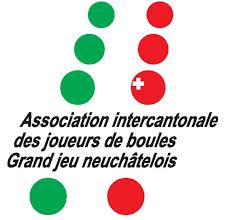
- Sources of information :
Video:
www.youtube.com/watch?v=222tl6_ofXc
www.youtube.com/watch?v=h_a3UP7SY2o
www.youtube.com/watch?v=9ZtjZGjAwfc - Gallery:
- Documents:
- Name of sport (game): Quoits
- Name in native language: Quoits
- Place of practice (continent, state, nation):
England, Wales, Scotland, USA
- History:
Source: https://www.historicalfolktoys.com/catcont/3012.html
The game of quoits may have evolved from ancient Greece, where athletes enjoyed throwing a discus for competition. Peter Brown, president of the National Quoits Association, believes that the Greeks passed quoits to the Romans as a weapon of war. His theory continues with the thought that the Romans brought the game to Britain. He even suggests that the origins of the game go back to the Minoan Empire circa 2000 B.C. because the boy king of Knossos evidently used quoits as a weapon on slaves if they tried to escape.
Quoits was made illegal in 1388 by Sporting Regulations, but by the 15th century, it had become a favorite organized sport in English pubs and taverns. The first official rules for the game of quoits were printed in the April, 1881, edition of The Field in northern England. The National Quoits Association was formed in 1986.
There are several different games of quoits being played in England today: The Northern Game, The Long Game, East Anglian Quoits, and Sward or Lawn Quoits. Sward Quoits is played with a clay square to which the stake or hob is set in, but it can become muddy and difficult to maintain. Many people happily adapt this game and its rules for backyard play with the hob or stake set in the grass.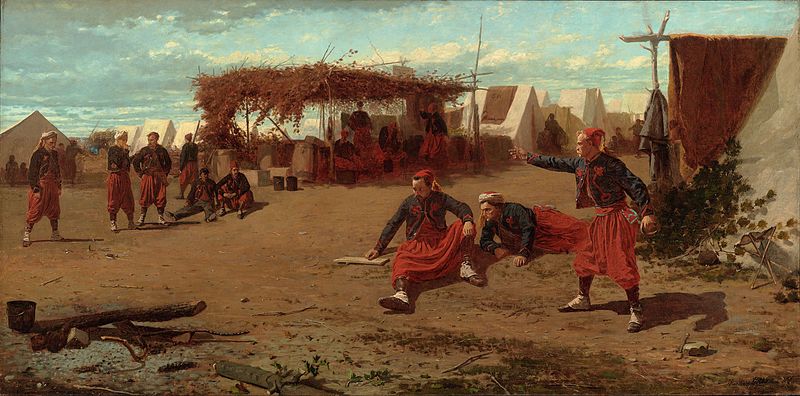 Winslow Homer, Pitching Quoits, 1865
Winslow Homer, Pitching Quoits, 1865Quoits was played during the American Revolutionary War by both British and Continental soldiers to pass the time. It has been said that the game of horseshoes was derived from quoits because some people could not afford to have quoits made, so they used what was similarly available: old horseshoes!
Miniature versions of indoor quoits were played near the Welsh-English border for at least a century. It seems that the game was invented toward the end of the 19th century, but the history of indoor quoits is not really known. A game called Rings was played in Northern England. Now, many variations of the game exist. "Deck quoits" were made from rope and used on cruise ships. "Rope quoits" is probably the same game and is popular in Australia. English and Welsh descendants in parts of Pennsylvania play the game with the hob set at a slight angle on a slate board instead of a clay bed because they resided in "the slate belt."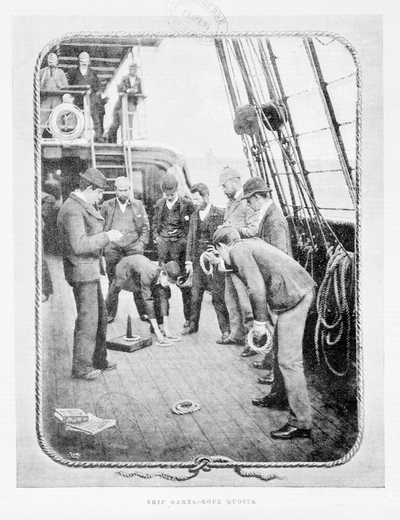 April 2, 1894, Shows group of young men playing quoits on ship deck
April 2, 1894, Shows group of young men playing quoits on ship deck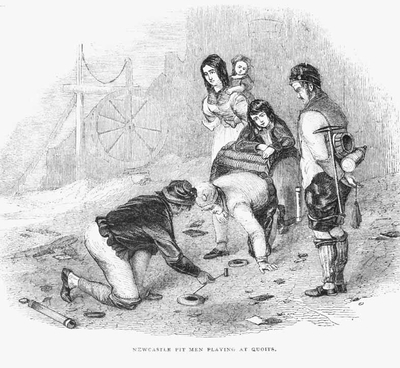 Newcastle Miners playing Quoits, printed in 1843
Newcastle Miners playing Quoits, printed in 1843 - Description:
Source: http://www.quoitsdirect.com/QuoitRules.htm
STARTING A GAME:
The quoit boards are placed 18 feet on center (from hub to hub).
One-on-one - You pitch from the same side of the boards when you travel to the opposing board. Non-diagonally. (One-on-One Positions).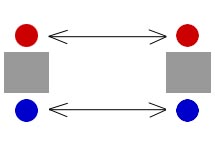 Two-on-two (a.k.a. couples or doubles) - Your partner pitches from the diagonal side of the board (Two-on-Two Positions).
Two-on-two (a.k.a. couples or doubles) - Your partner pitches from the diagonal side of the board (Two-on-Two Positions). 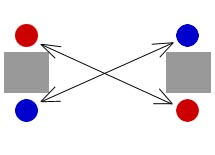 There are 4 quoits (2 for you and 2 for your partner). You can determine who throws the first pitch of the first game. After the first game the loser of the prior game makes the first pitch to start the new game.
There are 4 quoits (2 for you and 2 for your partner). You can determine who throws the first pitch of the first game. After the first game the loser of the prior game makes the first pitch to start the new game.
Pitching turns alternate with each quoit.
The pitcher's forward foot may not extend beyond the hub of his "home" board.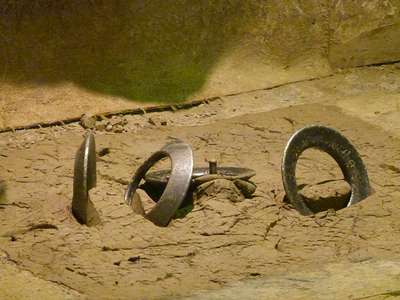
DETERMINING THE SCORE:
The first person or team to reach a score of 21 wins the game.
Every "ringer" (meaning the quoit landed on the hub) is worth 3 points.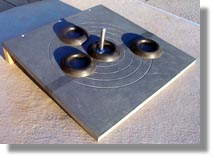 If a player should make a ringer and have his second quoit closer to the hub than his opponent, he receives 4 points (Three points for the ringer and 1 point for the quoit closest to the hub).
If a player should make a ringer and have his second quoit closer to the hub than his opponent, he receives 4 points (Three points for the ringer and 1 point for the quoit closest to the hub).
Each ringer pitched counts as 3 points, except when the same player pitches two ringers, one directly on top of the other. This player is then awarded 3 additional points, for a total of 6 points.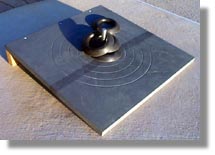 When the first player pitches a ringer which is topped by an opponent, it is the opponent only who receives 3 points.
When the first player pitches a ringer which is topped by an opponent, it is the opponent only who receives 3 points. 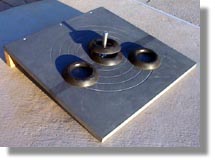 When the first player pitches a ringer which is topped by an opponent and then topped by the first player again, the last ringer made by the first player counts as 3 points for the first player. As a premium, when four ringers are made, the player pitching the last ringer wins the game.
When the first player pitches a ringer which is topped by an opponent and then topped by the first player again, the last ringer made by the first player counts as 3 points for the first player. As a premium, when four ringers are made, the player pitching the last ringer wins the game.
Every "leaner" (meaning the quoit is leaning against or on top of the hub, but not a ringer) is worth 1 point.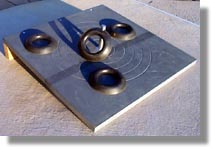 If there are no ringers and leaners the person who throws the closest quoit gets one point. If the same person's second quoit is the next closest he/she gets two points.
If there are no ringers and leaners the person who throws the closest quoit gets one point. If the same person's second quoit is the next closest he/she gets two points.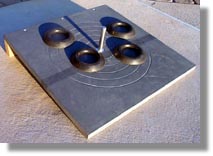 The rings on the board are used to determine the closest quoit. If you can not determine the closest quoit from the front side (closest side of the quoit to the hub) you can usually determine it by comparing the backside (the side of the quoits furthest from the hub) to the outer rings.
The rings on the board are used to determine the closest quoit. If you can not determine the closest quoit from the front side (closest side of the quoit to the hub) you can usually determine it by comparing the backside (the side of the quoits furthest from the hub) to the outer rings.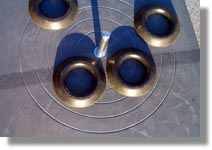 If a quoit is touching the ground, or has touched the ground, it is a "dead quoit". Remove it from the board before the next pitch. If you don't remove it any quoits that touch a dead quoit are also dead.
If a quoit is touching the ground, or has touched the ground, it is a "dead quoit". Remove it from the board before the next pitch. If you don't remove it any quoits that touch a dead quoit are also dead. 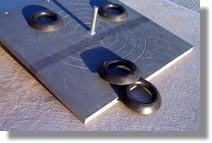 A quoit can be hanging off the side of the board. As long as it has not touched the ground the quoit is still good.
A quoit can be hanging off the side of the board. As long as it has not touched the ground the quoit is still good. 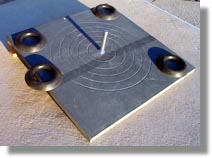 This is called the daylight rule because you can see "daylight" through the quoit since it is hanging off of the board. This rule is sometimes disputed so decide if you want to play "Daylight Counts" before you start playing against your opponent.
This is called the daylight rule because you can see "daylight" through the quoit since it is hanging off of the board. This rule is sometimes disputed so decide if you want to play "Daylight Counts" before you start playing against your opponent.
Interference due to a wandering dog or small child (which sometimes happens) is grounds for a "re-throw" (a.k.a. do-over) if the quoit is deflected during release or in mid-air.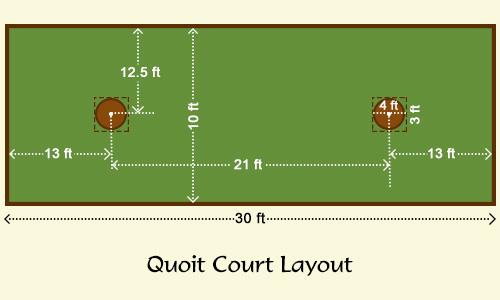
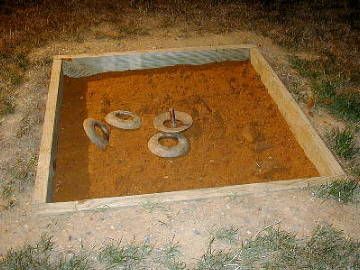
Source: https://www.tradgames.org.uk/games/Quoits.htm
The Northern Game
The Association of Amateur Quoits Clubs for the North of England was the name give to the official body that laid down the 15 rules that were published in "The Field" in 1881. This set of rules constituted what is now called The Northern Game and it has remained largely unchanged ever since. Although the Northern Game has lost some of it's popularity, it is still played seriously and enthusiastically in the North of England under the auspices of The National Quoits Association which was formed in 1986 and is undergoing something of a resurgence of late.The Long Game
Quoits however, is a split sport, much like the game of Rugby, because independently, Wales and Scotland have long been playing a distinctly different game with a similar proud history. In fact, "The Long Game" or "The Old Game" is also played in parts of England, notably East Anglia and Liverpool , but is far more rare in that country as the new century begins.
In the Northern game, if more than one quoit lands on the hob, then only the top quoit scores whereas in the Long Game, the scoring is simply that a player scores a point for each quoit nearer to the pin than his opponent. The reason for this is that the pin in the Long Game is knocked down flush with the clay surface so encircling the pin is not really a significant part of the game. The Long Game then is more akin to Bowls in play with the pin acting as a simple target. However, this simplicity belies the difficulty of the game which, in common with many celtic sports, is a test of strength as much as skill. The hobs are 18 yards apart, fully 7 yards greater than the Northern Game while the quoits are typically around 9 inches in diameter and weigh up to 11 pounds, almost double that of the Northern game.East Anglian Quoits
The long game is still played in England at the turn of the century but in a modified form that sees the quoits reduced in size and somewhat different rules being adopted. The English stopped fielding a side at the internationals some time ago presumably because the differences between the two variations had grown two large and the gap could not be easily bridged. The East Anglian game is unique in that ringers score a clean two points regardless of the opponent's efforts and are immediately removed prior to the next throw. Quoits on their backs and quoits that land inclined in a backwards direction are discounted and also removed immediately. The quoits tend to be smaller than those used in the Scottish and Welsh games but the distance is maintained at 18 yards.Sward or Lawn Quoits
The difficulty of maintaining the clay squares and the muddiness that can occur on a wet day makes genuine traditional quoits a rare sport. However, all is not lost because for many decades people have been playing a more simple version by simply putting 2 stakes in a lawn. Organisers of fetes, horse fairs and similar public functions sometimes set up temporary quoits pitches in this way and such games are often referred to as Sward Quoits. Sward Quoits has it's own varying complexities depending upon the type of ground being played upon and the height of the hobs and so forth. People wishing to play quoits in their back gardens or any open space happily emulate Sward Quoits in the same way.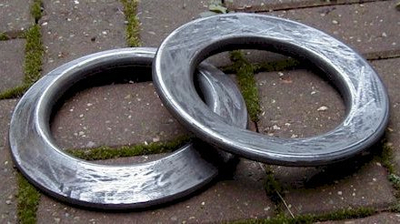
- Current status:
Practiced.
Source: https://www.tradgames.org.uk/games/Quoits.htmA traditional miniaturised version of Indoor Quoits has existed around the Welsh/English border for at least a century and a game called Rings was popular in the North in the 1930s.
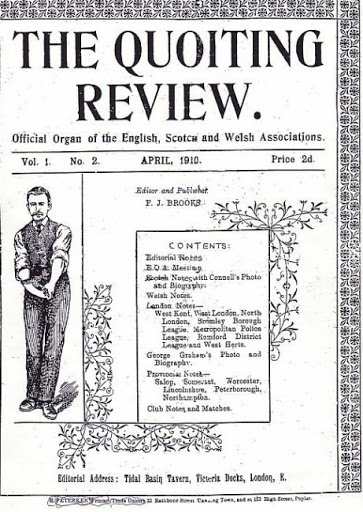 While all the above traditional English games survive to the modern day, many modern variants can be found using either home-made equipment or interpretations from modern manufacturers. Deck Quoits played with quoits made from rope has been a popular pastime on cruise ships for decades. Rope Quoits, which is presumably the same game, has recently become a trendy outdoor activity, especially in Australia.
While all the above traditional English games survive to the modern day, many modern variants can be found using either home-made equipment or interpretations from modern manufacturers. Deck Quoits played with quoits made from rope has been a popular pastime on cruise ships for decades. Rope Quoits, which is presumably the same game, has recently become a trendy outdoor activity, especially in Australia.The USA has a burgeoning Quoits community around New Jersey although the distance they put between the quoits seems to be much reduced at 21 feet (7 yards). Another derivative seems to have become popular around Pennsylvania where the hobs are set 6 yards apart on slightly angled slate boards instead of clay beds. The heart of this game is an area called, for obvious reasons, "the slate belt", populated by people of primarily English and Welsh descent. Pennsylvania also has some clay bed pitches.
Canada, too, has enjoyed a surge of Quoits interest throughout the 1990's that seems to be centred around Nova Scotia and Ontario. The sport is also played in Colombia under the name Tejo.
Current leagues Traditional quoits:
United Kingdom
Allen Valley Quoits League, Northumberland
Danby Invitation Quoits League, North Yorkshire
Lower Dales Quoits League, North Yorkshire
North Yorkshire Moors League, North Yorkshire
Montgomeryshire County Quoits League, Montgomeryshire
Mount Bures (Essex) Quoits Team
Bures, (Suffolk) Quoits TeamUnited States
United States Quoiting Association (USQA)
Mercer County Church Steel Quoit League, New Jersey
Pottstown German Club 3lb League, Pottstown Pa
Slate Belt Men's Quoit League, Bangor PA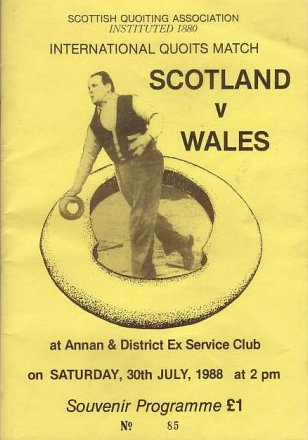
- Contacts:
The United States Quoiting Association
Webside: https://www.usqa.org/
Fb: https://www.facebook.com/quoitinamerica/
YouTube: https://www.youtube.com/channel/UCKrz0jcU-GPA0JG90ixUuUg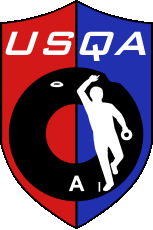
The Lower Dales Quoits League
Webside: http://www.lowerdalesquoits.co.uk/Bures Quoit League
Webside: http://www.bures-online.co.uk/Quoits/quoits.htmMercer County Church Steel Quoit League
Webside: http://mccsql.tripod.com/Zetland Quoits League
Fb: https://www.facebook.com/Zetlandquoits - Sources of information :
Articles:
https://www.tradgames.org.uk/games/Quoits.htmVideo:
https://www.youtube.com/watch?v=4uaw5sm-xN4
https://www.youtube.com/watch?v=3yC8VdnSVtc
https://www.youtube.com/watch?v=sdvojNs6mlU
https://www.youtube.com/watch?v=QnWUz58mLxA
https://www.youtube.com/watch?v=ZZ3lq6fwK1k - Gallery:
- Documents:
- Name of sport (game): Rackets
- Place of practice (continent, state, nation):
United Kingdom, United States and Canada
- History:
In its earliest form during the 18th Century, Rackets was played in the open on the walls of the yards of the two main debtor's prisons, the King's Bench and the Fleet. Gentlemen, imprisoned until they could find the wherewithal to repay their creditors, amused themselves with many different activities around the prison yard. These included skittles, fives, which was played both with the hand and a bat (as at Westminster School), and some brought tennis racquets with them and improvised against any convenient wall, sometimes with no side walls and always without a back wall.
There is mention of Rackets at the Fleet in a poem of 1749 and in John Howard's report on the state of prisons in England and Wales published in 1780. It is not until the early 1800s that Rackets becomes part of life outside the prisons. In his Book of Sports and Mirror of Life published by Pierce Egan in 1832, there is a long description of Rackets mentioning several open rackets courts other than the King's Bench and the Fleet. One of these was at the Belvedere Tavern, Pentonville, where most of the Open Court Championships were played. Others were to be found elsewhere in London, again at public houses, at the Eagle Tavern on the City Road, The White Bear Kennington, the White Conduit House, and the Rosemary Branch, Peckham.”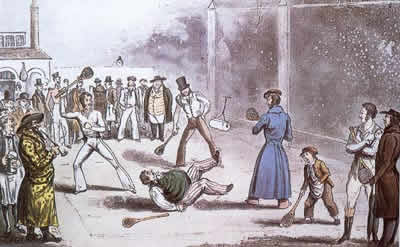
Source: https://www.wikiwand.com/en/Rackets_(sport)There are further records of courts at Bristol, Bath, Birmingham and Belfast. Egan states that if a gentleman sought a game at a tavern he would have to mix with those not of the highest rank in society. Implicit in this observation is that the debtors prison may have had a higher class of player (in both meanings of the word), and mention is made of a Major Campbell who was the best player in the King's Bench through having been incarcerated there for fourteen years. Spectators as well as prison visitors often came to watch matches in the prisons. Dickens mentions Rackets in the Pickwick Papers, as Mr Pickwick had the misfortune to be incarcerated in the Fleet. From Dickens' description the Fleet court appears to have had a front wall and one sidewall similar to a Jai Alai fronton. In 1814 there were four courts at the King's Bench and six Racket masters to look after them. Early courts outside the prisons had a front wall only, about 40 feet wide and 45 ft high.
Outside prisons and taverns, Harrow was the first school at which Rackets was played, probably from the early 1820s when the schoolyard was enlarged. When the first Lawn Tennis Championships were played at Wimbledon later in the century, Old Harrovian Rackets player Spencer Gore would win the singles.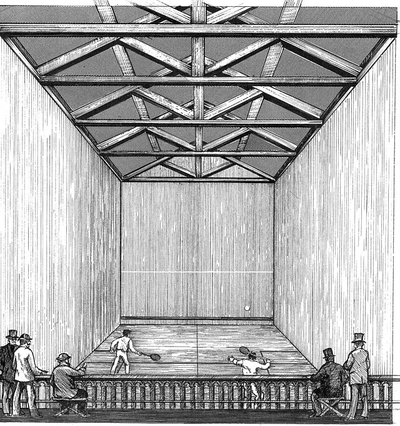
Interior of the Eglinton Castle Rackets Hall in 1842.
Source: https://www.wikiwand.com/en/Rackets_(sport)In the middle of the 19th Century, Rackets played in covered courts began to predominate. The MCC built a court in 1844 next to the old Tennis court, and the old Princes Club opened in 1853 with several courts as well as two Tennis courts. The main competition court at Princes set the standard dimensions for most closed courts built from then up to the present day, being 60' long by 30' wide. Before this on the open courts, doubles was played on a court of 80' x 40' with two players playing up at the front of the court and two at the back.
Furthermore, and again about the middle of the 19th century, the growing popularity of the indoor game caused Rackets at the open courts attached to public houses to fall into desuetude. Rackets increasingly developed as a game for the wealthy. Although Lord West built a court at Buckhurst Park in Sussex in the 1850s and The Earl of Eglinton and Winton built one at Eglinton Castle, his home in Scotland, Rackets did not take off as a private country house game to the same extent as Tennis did later in the century.
Both Oxford and Cambridge universities had courts by 1855, the date of the first Varsity match. There were courts built at Torquay in 1859 and the first covered court at Harrow school, built in 1865. This has recently been reconstructured to create the Prenn Hue Williams Court.
Devonshire Park at Eastbourne included a Rackets court built in 1870 as part of its general recreational facilities. Between 1870 and 1890, courts were built at the new Princes Club, Manchester, Liverpool and in 1888 the courts at The Queen's Club were opened. - Description:
Rackets is played in a 30-by-60-foot (9.1 by 18.3 m) enclosed court, with a ceiling at least 30 feet (9.1 m) high. Singles and doubles are played on the same court. The walls and floor of the court are made of smooth stone or concrete and are generally dark in colour to contrast with the white ball. A player uses 30.5-inch (77 cm) wooden racket to hit a 38 mm (1.5 inch) hard white ball weighing 28 grams (1 oz). Championship quality Balls are made via two different sources. One such ball is manufactured in America using a machine developed by former Marlborough professional Bill Gordon and the other type is manufactured in England by former Winchester professional Peter Ashford. The Rackets ball is durable and can last for months at a time, however its outer covering (strong tape) has to be recovered regularly. With regard to the racket itself, as of February 2021, two companies produce rackets racquets, Grays of Cambridge (UK) and Gold Leaf Athletics (US).
In gameplay, a good stroke must touch the front wall above a 26.5 inches (67 cm) high wooden (often cloth-covered) board before touching the floor. The ball may touch the side walls before reaching the front wall. The player returning a good stroke may play the ball on the volley, or after one bounce on the floor. Gameplay is basically identical to squash, albeit without drop shots or lobs! The speed of the ball and tension of the racket strings used means that the play is fast, and potentially dangerous. Lets (replayed points) are common, as the striker should not play the ball if doing so risks hitting another player. Yet unlike in squash, strokes are not given if a player gets in the way such is the often exciting and frenetic gameplay. However, this danger is minimal, since the patient coaching all players receive engrain a solid tactical awareness in all participants. Matches are normally observed by a "marker" and a “referee”, who has the duty to call "Play" after each good stroke to denote that the ball is "up". Games are to 15 points, unless the game is tied at 13–all or 14–all, in which case the game can be "set" to 16 or 18 (in the case of 13–all) or to 15 or 17 (in the case of 14–all) at the option of the player first reaching 13 or 14. Only the server (hand-in) can score—the receiver (hand-out) who wins a rally becomes the server. Return of service can be extremely difficult, and, in North America, only one serve is allowed. At the top level of the game, aces (when a server beats their opponent without their opponent touching the ball) are somewhat rarer which results in physically draining rallies. Matches are typically best of five games, but earlier rounds of some tournaments can be best of 3 games - or even an adapted 'first to 30 points' game.
The main shots played are the volley, forehand and the backhand all similar to the way one plays these in squash. Yet, in recent years the game of rackets has incorporated much greater scope for innovation in the form of reverse angles and use of power rather than the more traditional use of placement and ‘cut’. In any case, the rules and scoring in squash have evolved in the last hundred years or so whereas Rackets has changed little; the main difference today is that players are now allowed brief rest periods between games. In the past, leaving the court could mean forfeiting the match, so players kept spare rackets, shirts, and shoes in the gutter below the ‘tin’ on the front wall! This was often cumbersome and the rules were changed to allow players to leave the court to change their racket mid-game and also to have a break between games. Continuous play is paramount and a game of singles or doubles is an exhilarating spectacle and guaranteed entertainment for participants and spectators alike.
Source: www.tennisandrackets.com/rackets/court-game/about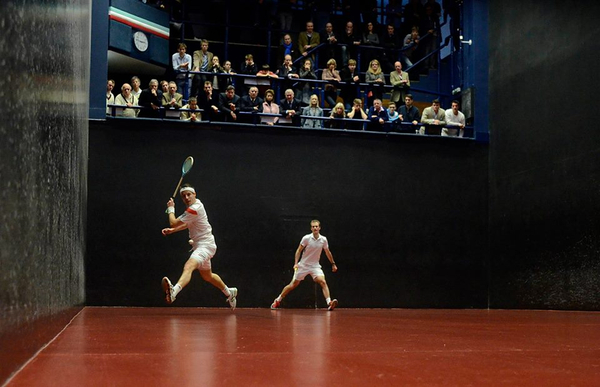
https://thesporting.blog/blog/2017/9/13/know-the-game-rackets - Current status:
The Neptune World Ranking System
The first official ranking list was created in Rackets in 2010/11 as an evolution of the Big-Red System and has been adapted to suit the current fixture calendar. The initial ranking system was sponsored by Neptune Investment Management, including both male and female competitors, and incorporated all tournament matches and assigned every player a nominal ‘ranking point’ rating which determined their position in the world. Players could win or lose points depending on their performance in the tournaments during a season, at which point at the end of the season a player was ‘re-calibrated’ (denoting an increase in points due to their participation in more than one tournament) or ‘eroded’ (reducing their number of points due to inactivity).
This system was refined over the summer of 2020 and many of the earlier inaccuracies and anomalies removed; and now needs further play to authenticate itself. This system is, however, slow moving in the top ten due to its source code being predicated on a zero-sum algorithm but is reasonably representative for those players below the top 15-20. Following reform of the World Challenge process a new Elite System was introduced in 2014/5 which is now used predominantly to seed major tournaments.The Elite System
In the Elite Ranking System, for both singles and doubles, players accumulate points individually and as a designated doubles partnership in specified Qualifying Tournaments (QTs) to determine their Elite World Singles Ranking, which would also be linked to their World Championship Challenge points standing.The singles ranking system has been refined in January 2021 to run over a rolling three-year cycle, with the current year carrying higher points than the previous year, itself higher than the year before. This add relevance to the ranking.
There are currently plans to evolve the doubles ranking system as an individual system, so a pair is the sum of its components. The finer details are still being defined.
Seeding for major tournament, including all QTs, are taken from the top of the Elite System, following by the Neptune World ranking System for those below the threshold.The World Challenge
Players and doubles partnerships accumulate points in a two-year Qualifying Period (QP), with the top ranked player/pair (excluding the holder/holders of the World Championship title) winning through to play in the World Championship. In recent years ‘eliminator’ matches have been used to determine a challenger for the world championship. An Eliminator (if necessary) and a Challenge Match are scheduled to take place every two years, but not where the current World Champion has won three out of the four US Opens and British Opens and one Tier 2 Qualifying Tournament in either North America or UK during the Qualifying Period and does not wish to defend. In the event that the reigning World Champion has won the requisite events to stave off a defense, it would be the choice of the existing champion to decide whether he/she would defend. The World Championship procedures have been refined in the 2010s to accommodate a fast-improving group of ‘world class’ players who are able to compete on the global tour.The Men’s World Championship (in both singles and doubles) is a best of seven game match played over two legs. The Women’s World Championship is a best of five game match where a potential challenger wins through to play against the reigning World Champion.
Source: www.tennisandrackets.com/rackets/court-game/ranking-procedures - Contacts:
The Tennis & Rackets Association
The T&RA Ltd
c/o The Queen’s Club
Palliser Road
West Kensington
London
W14 9EQ
Tel: 020 7835 6937
Fax: 020 7385 8920
Website: www.tennisandrackets.com
E-mail:This email address is being protected from spambots. You need JavaScript enabled to view it.
YouTube: www.youtube.com/channel/UCz4vpvhBrBB-ZLFRzCxwBCA
Fb: www.facebook.com/tennisandrackets
Twitter: twitter.com/tra_ltd
- Sources of information :
- Gallery:
- Name of sport (game): Ranggeln
- Name in native language: Ranggeln
- Place of practice (continent, state, nation):
Austria (Salzburg, Tyrol)
- History:
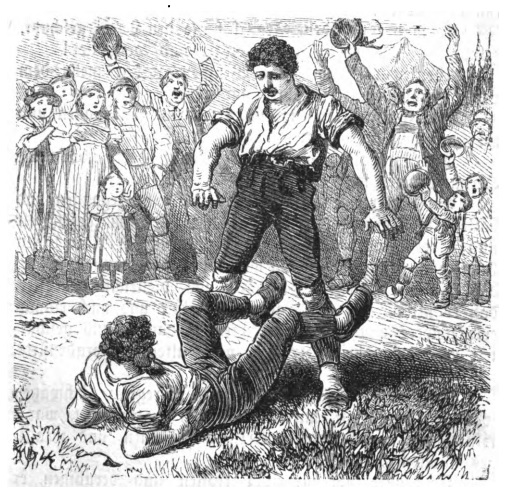 Ranggel, 1875
Ranggel, 1875 - Description:
Ranggeln is played on grass, outdoor, during the summer festivals, and on mats during the winter season.Several weight and age categories.
The wrestlers (men or women) wear a special shirt & trouser. Wrestlers can grip anywhere in clothes: jacket and trouser. The goal is to put the opponent back to the ground on the two shoulders at the same time (even by rolling).
- Name of sport (game): Rebatta
- Name in native language: rebatta
- Place of practice (continent, state, nation):
Valle d'Aosta, Italy
Sections of the Valdostana Rebatta Association coincide with the municipalities of residence of the players and de facto indicate the territory in which the game is officially practiced and in which the championships are held. The sections adhering to the Association are: Aosta, Aymavilles, Bionaz, Charvensod, Chevrot, Cogne, Doues, Gignod, Gressan, Introd, Ollomont, Pollein, Saint-Christophe, Sarre, Valpelline.
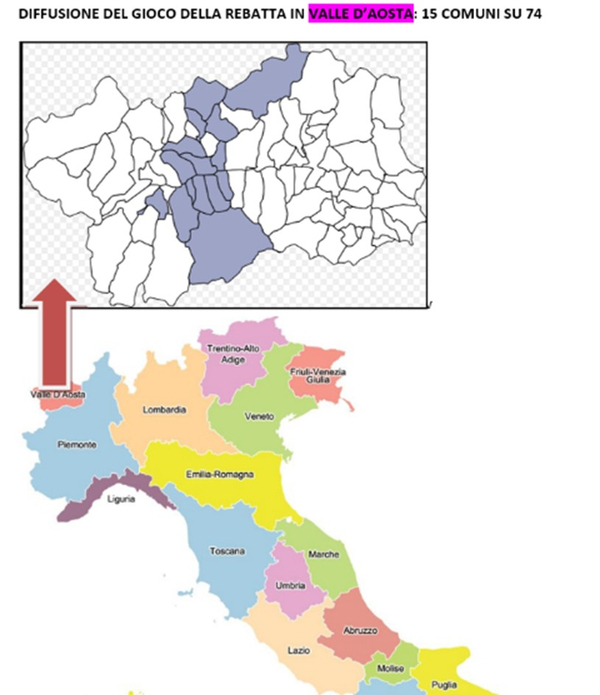
- History:
Rebatta, a traditional Aosta Valley game, belongs to the large family of bat-ball throwing games. Golf and baseball are the best known relatives but similar recreational and sporting practices are numerous throughout the world.
According to a thesis by prof. Pierino Daudry, based on the studies of the ethnologist Arnold Van Gennep, disciplines such as rebatta are the evolution of ancient agro-pastoral rituals transformed over the centuries into traditional games until they became sports with real regulations.
The practice of this game is recognized by direct testimonies already in the second half of the 19th century in the Aosta area and in the Coumba Freide. Likewise, the spread of similar games is known in the valleys of Cogne, Champorcher and Valtournenche (tsanfolla).
The game was played to win "the hand", that is, the sum of the points scored by the team members for a single innings. To win the challenge you had to win a pre-established number of "hands".
The value of a single measure was counted in steps, which frequently generated discussions.
Later we moved on to calculate a point every 15 steps and to delimit a primitive regulated playing field.
After the Second World War, the seed began that would lead to the transformation of a rural ludo practice into a sporting activity.
The first competitions are organized, the players refine their technique with the first training sessions and the rudimentary equipment becomes increasingly refined. - Description:
Let's first define what the typical tools of this sport are and their functions.
The “Rebatta”: it is a ball with a diameter of 30 mm; it is made of wood (in this case weighed down by an integral covering made with metal nails planted in the wood) or metal.
The "Fioletta": is a pipe-shaped wooden instrument, about 20 cm long, with a lever function. The "rebatta" is placed on the slightly hollowed end in contact with the ground; the other end is struck from the "masetta" to project the ball into the air.
The "Masetta": is a wooden club 100 - 140 cm long, which ends with a solid wood "head"; the bat is called "baton", the head "maciocca".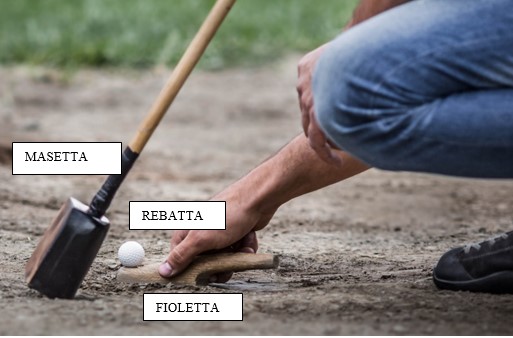
Having placed the "fioletta" on the ground, the player places the "rebatta" at one end. Having held the "masetta" with both hands, he touches the nozzle of the "fioletta" projecting the ball into the air (action defined as "levoù") to hit it on the fly and throw it as far as possible.
The playing field is an isosceles triangle with the vertex located at the center of the serving area (called "place"), a rectangle of at least three meters by two. The height of the triangle represents the theoretical throwing line, the length and orientation of the field, it varies depending on the categories: from 180 to 240 meters. Inside it, lines are drawn with ropes at a distance of 15 meters , which determine the attribution of points for each throw. The width of the court must be 50 meters at the height of the tenth point line.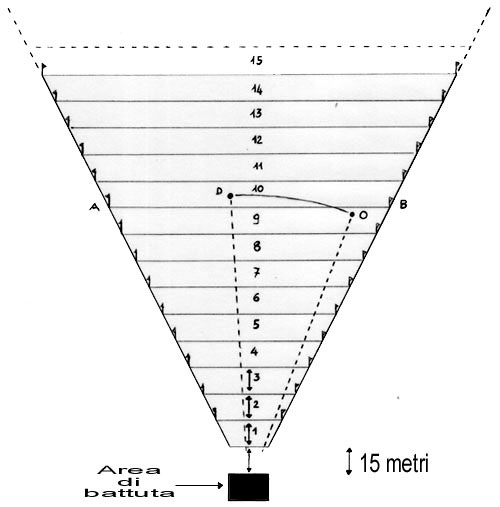
- Current status:
Practiced
From this ferment arose the need to have a common organizational structure which led to the birth of the Valdostana Rebatta Association in 1957.
A necessary transition for the survival of these disciplines which have had to and must deal with the weight of globalisation, modernity, the media coverage of Olympic or high level sports which now have little to do with the image of a territory and its values cultural that it expresses.
The institutional journey continues and in 1977 the rebatta association co-founded the newly formed FENT (federation esport de noutra tera) together with the disciplines tsan and fiolet, to which the game of palet and then morra were later added.
The path towards the sporting status of the Val d'Aosta disciplines continued in 1994 with the membership of FIGEST (Italian federation of traditional games and sports) which became part of CONI (Italian Olympic Committee) as an associated discipline, allowing rebatta to enter the national sporting panorama .
The European association of traditional games and sports (AJEST) was also founded in 2001 as a platform for information, study, representation, projects and cultural exchanges between member organisations.The activity is mainly concentrated in the spring - summer period but continues until late autumn, with individual or team competitions.
The age trophy is a one-day 10-bar team competition that normally opens the season at the beginning of March. Teams made up of six players divided into age groups participate: up to 15 years, from 16 to 25 years, from 26 to 35 years, from 36 to 45 years, from 46 to 55 years, over 56 years.
The spring calendar continues with the team championship which engages fans every Sunday from mid-March to early June. There are five men's categories (I, II, III, IV, V), one female and one junior. The matches are played over 20 bars for each player.
Players are classified based on their individual batting averages, calculated by counting the results obtained in all official events of the season.
The registration of the teams must be done following the quorum criterion. The team quorum is equal to the sum of the averages, valid for the current championship, of the five elements that compose it. Based on their quorum, the team participates in the tournament in one of the five merit categories. The winning team of the first category championship wins the title of champion of the Aosta Valley, the scudetto.
On April 25th of each year, the individual tournament is held which wins the Aosta Valley rebatta champion over a distance of 10 bars. Another individual event is the "champion d'été", a classic summer event, the only competition with a direct elimination draw in the discipline.
The activity resumes in autumn, from mid-September to mid-October with the autumn team championship and the individual "champion d'auton".
The discipline has around 300 members from around fifteen sports clubs which have formed the Rebatta Aosta Valley association since 1957. - Importance (for practitioners, communities etc.):
At that time, gaming had a purely recreational role, a concept of free time that was very different at the time from how we know it today, both in terms of availability and economic conditions.
An expression of rural culture and economy, the game of rebatta was linked to the spring season, the practice in fact stopped with the growth of the grass in the meadows.
The kids played and on holiday days the adults too.
Teams were formed on the spot, based on the number of players by drawing lots.
(as is done in all games, hide and seek, up to His Majesty football; here too the children in the courtyards form teams in this way)
Other team formation criteria could give rise to challenges between bachelors and married men or between people from different hamlets. - Contacts:
Valdostana Rebatta Association,
Les Iles 1, 11020 Brissogne (AO)
Tel. 0165.762779
E-mail:This email address is being protected from spambots. You need JavaScript enabled to view it.
Web: www.avrebatta.com
Facebook: A.V. REBATTA
Instagram: https://www.instagram.com/associachonvaldotenarebatta/
YouTube: Rebatta Republic
- Sources of information :
Articles:
https://www.bblacascata.com/sport-tradizionali-la-rebatta/
https://www.saliinvetta.com/culture-e-tradizioni/1335-tsan-fiolet-palet-rebatta-la-tradizione-sportiva-valdostana
https://www.valledaosta-guidaturistica.it/cultura/giochi-tradizionali/
https://ancientgolf.dse.nl/stickball.htm
https://www.turismo.it/en/tradizioni/articolo/art/cosa-c-da-sapere-sulla-rebatta-valdostana-id-20160/Video:
https://www.youtube.com/watch?v=e6bpn6UZ92IThe information contained in the article comes from the following sources:
Fabrizio Vierin, President of Valdostana Rebatta Association
Source of photos used in this article and gallery:
Fabrizio Vierin, President of Valdostana Rebatta Association - Gallery:
- Documents:


